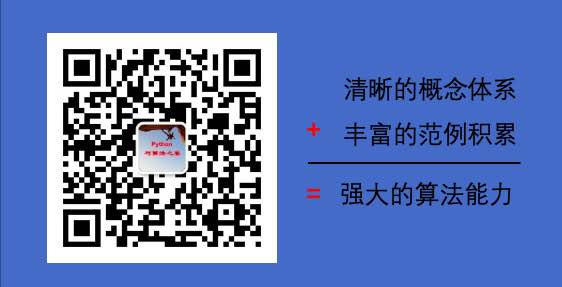1-1 Example: Modeling Procedure for Structured Data#
1. Data Preparation#
The purpose of the Titanic dataset is to predict whether the given passengers could be survived after Titinic hit the iceburg, according to their personal information.
We usually use DataFrame from the pandas library to pre-process the structured data.
import numpy as np
import pandas as pd
import matplotlib.pyplot as plt
import tensorflow as tf
from tensorflow.keras import models,layers
dftrain_raw = pd.read_csv('../../data/titanic/train.csv')
dftest_raw = pd.read_csv('../../data/titanic/test.csv')
dftrain_raw.head(10)

Introduction of each field:
- Survived: 0 for death and 1 for survived [y labels]
- Pclass: Class of the tickets, with three possible values (1,2,3) [converting to one-hot encoding]
- Name: Name of each passenger [discarded]
- Sex: Gender of each passenger [converting to bool type]
- Age: Age of each passenger (partly missing) [numerical feature, should add "Whether age is missing" as auxiliary feature]
- SibSp: Number of siblings and spouse of each passenger (interger) [numerical feature]
- Parch: Number of parents/children of each passenger (interger) [numerical feature]
- Ticket: Ticket number (string) [discarded]
- Fare: Ticket price of each passenger (float, between 0 to 500) [numerical feature]
- Cabin: Cabin where each passenger is located (partly missing) [should add "Whether cabin is missing" as auxiliary feature]
- Embarked: Which port was each passenger embarked, possible values are S、C、Q (partly missing) [converting to one-hot encoding, four dimensions, S,C,Q,nan]
Use data visualization in pandas library for initial EDA (Exploratory Data Analysis).
Survival label distribution:
%matplotlib inline
%config InlineBackend.figure_format = 'png'
ax = dftrain_raw['Survived'].value_counts().plot(kind = 'bar',
figsize = (12,8),fontsize=15,rot = 0)
ax.set_ylabel('Counts',fontsize = 15)
ax.set_xlabel('Survived',fontsize = 15)
plt.show()
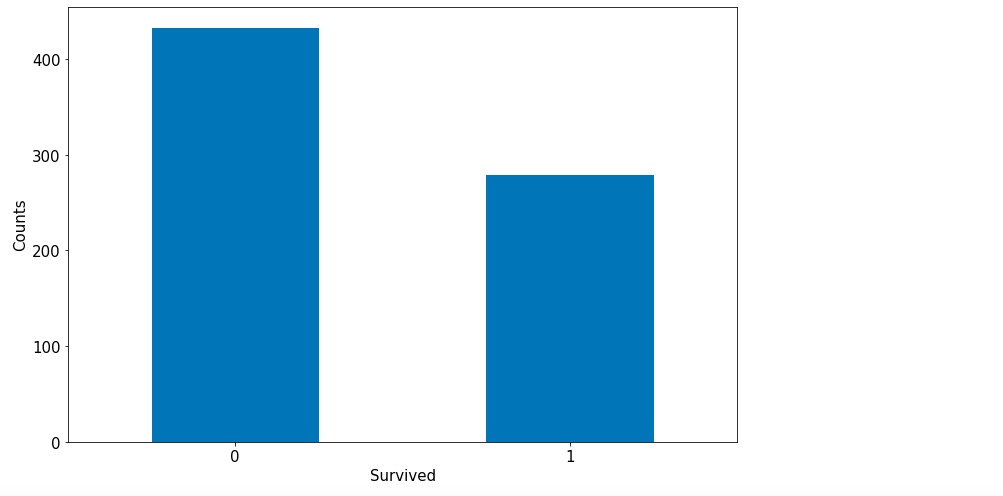
Age distribution:
%matplotlib inline
%config InlineBackend.figure_format = 'png'
ax = dftrain_raw['Age'].plot(kind = 'hist',bins = 20,color= 'purple',
figsize = (12,8),fontsize=15)
ax.set_ylabel('Frequency',fontsize = 15)
ax.set_xlabel('Age',fontsize = 15)
plt.show()
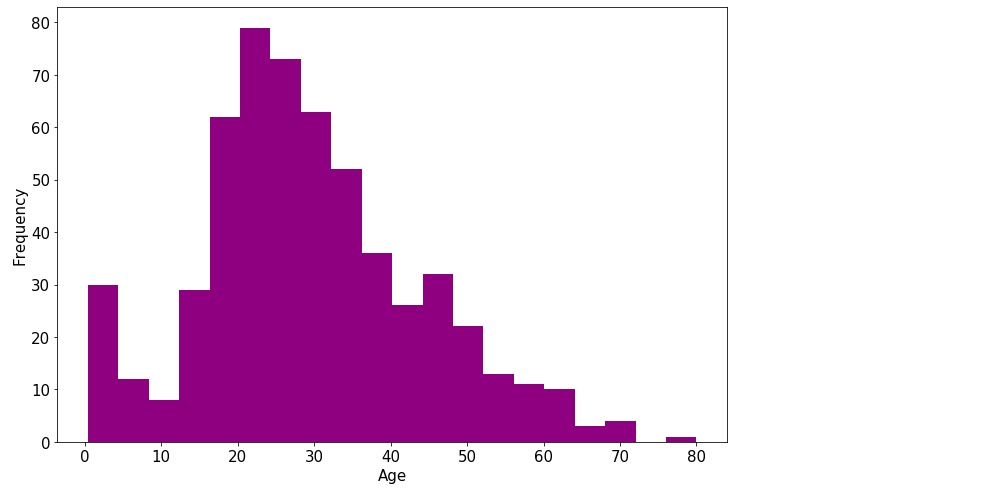
Correlation between age and survival label:
%matplotlib inline
%config InlineBackend.figure_format = 'png'
ax = dftrain_raw.query('Survived == 0')['Age'].plot(kind = 'density',
figsize = (12,8),fontsize=15)
dftrain_raw.query('Survived == 1')['Age'].plot(kind = 'density',
figsize = (12,8),fontsize=15)
ax.legend(['Survived==0','Survived==1'],fontsize = 12)
ax.set_ylabel('Density',fontsize = 15)
ax.set_xlabel('Age',fontsize = 15)
plt.show()
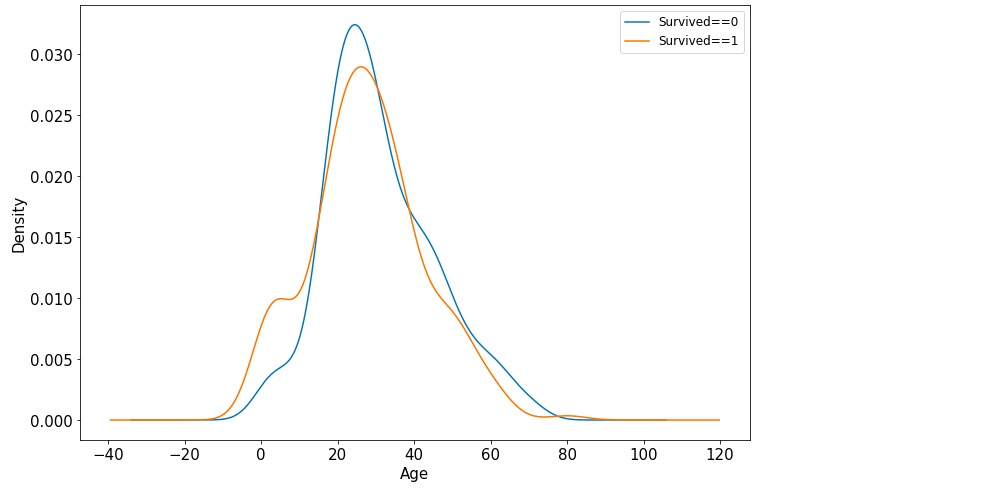
Below are code for formal data pre-processing:
def preprocessing(dfdata):
dfresult= pd.DataFrame()
#Pclass
dfPclass = pd.get_dummies(dfdata['Pclass'])
dfPclass.columns = ['Pclass_' +str(x) for x in dfPclass.columns ]
dfresult = pd.concat([dfresult,dfPclass],axis = 1)
#Sex
dfSex = pd.get_dummies(dfdata['Sex'])
dfresult = pd.concat([dfresult,dfSex],axis = 1)
#Age
dfresult['Age'] = dfdata['Age'].fillna(0)
dfresult['Age_null'] = pd.isna(dfdata['Age']).astype('int32')
#SibSp,Parch,Fare
dfresult['SibSp'] = dfdata['SibSp']
dfresult['Parch'] = dfdata['Parch']
dfresult['Fare'] = dfdata['Fare']
#Carbin
dfresult['Cabin_null'] = pd.isna(dfdata['Cabin']).astype('int32')
#Embarked
dfEmbarked = pd.get_dummies(dfdata['Embarked'],dummy_na=True)
dfEmbarked.columns = ['Embarked_' + str(x) for x in dfEmbarked.columns]
dfresult = pd.concat([dfresult,dfEmbarked],axis = 1)
return(dfresult)
x_train = preprocessing(dftrain_raw)
y_train = dftrain_raw['Survived'].values
x_test = preprocessing(dftest_raw)
y_test = dftest_raw['Survived'].values
print("x_train.shape =", x_train.shape )
print("x_test.shape =", x_test.shape )
x_train.shape = (712, 15)
x_test.shape = (179, 15)
2. Model Definition#
Usually there are three ways of modeling using APIs of Keras: sequential modeling using Sequential() function, arbitrary modeling using functional API, and customized modeling by inheriting base class Model.
Here we take the simplest way: sequential modeling using function Sequential().
tf.keras.backend.clear_session()
model = models.Sequential()
model.add(layers.Dense(20,activation = 'relu',input_shape=(15,)))
model.add(layers.Dense(10,activation = 'relu' ))
model.add(layers.Dense(1,activation = 'sigmoid' ))
model.summary()
Model: "sequential"
_________________________________________________________________
Layer (type) Output Shape Param #
=================================================================
dense (Dense) (None, 20) 320
_________________________________________________________________
dense_1 (Dense) (None, 10) 210
_________________________________________________________________
dense_2 (Dense) (None, 1) 11
=================================================================
Total params: 541
Trainable params: 541
Non-trainable params: 0
_________________________________________________________________
3. Model Training#
There are three usual ways for model training: use internal function fit, use internal function train_on_batch, and customized training loop. Here we introduce the simplist way: using internal function fit.
# Use binary cross entropy loss function for binary classification
model.compile(optimizer='adam',
loss='binary_crossentropy',
metrics=['AUC'])
history = model.fit(x_train,y_train,
batch_size= 64,
epochs= 30,
validation_split=0.2 #Split part of the training data for validation
)
Train on 569 samples, validate on 143 samples
Epoch 1/30
569/569 [==============================] - 1s 2ms/sample - loss: 3.5841 - AUC: 0.4079 - val_loss: 3.4429 - val_AUC: 0.4129
Epoch 2/30
569/569 [==============================] - 0s 102us/sample - loss: 2.6093 - AUC: 0.3967 - val_loss: 2.4886 - val_AUC: 0.4139
Epoch 3/30
569/569 [==============================] - 0s 68us/sample - loss: 1.8375 - AUC: 0.4003 - val_loss: 1.7383 - val_AUC: 0.4223
Epoch 4/30
569/569 [==============================] - 0s 83us/sample - loss: 1.2545 - AUC: 0.4390 - val_loss: 1.1936 - val_AUC: 0.4765
Epoch 5/30
569/569 [==============================] - ETA: 0s - loss: 1.4435 - AUC: 0.375 - 0s 90us/sample - loss: 0.9141 - AUC: 0.5192 - val_loss: 0.8274 - val_AUC: 0.5584
Epoch 6/30
569/569 [==============================] - 0s 110us/sample - loss: 0.7052 - AUC: 0.6290 - val_loss: 0.6596 - val_AUC: 0.6880
Epoch 7/30
569/569 [==============================] - 0s 90us/sample - loss: 0.6410 - AUC: 0.7086 - val_loss: 0.6519 - val_AUC: 0.6845
Epoch 8/30
569/569 [==============================] - 0s 93us/sample - loss: 0.6246 - AUC: 0.7080 - val_loss: 0.6480 - val_AUC: 0.6846
Epoch 9/30
569/569 [==============================] - 0s 73us/sample - loss: 0.6088 - AUC: 0.7113 - val_loss: 0.6497 - val_AUC: 0.6838
Epoch 10/30
569/569 [==============================] - 0s 79us/sample - loss: 0.6051 - AUC: 0.7117 - val_loss: 0.6454 - val_AUC: 0.6873
Epoch 11/30
569/569 [==============================] - 0s 96us/sample - loss: 0.5972 - AUC: 0.7218 - val_loss: 0.6369 - val_AUC: 0.6888
Epoch 12/30
569/569 [==============================] - 0s 92us/sample - loss: 0.5918 - AUC: 0.7294 - val_loss: 0.6330 - val_AUC: 0.6908
Epoch 13/30
569/569 [==============================] - 0s 75us/sample - loss: 0.5864 - AUC: 0.7363 - val_loss: 0.6281 - val_AUC: 0.6948
Epoch 14/30
569/569 [==============================] - 0s 104us/sample - loss: 0.5832 - AUC: 0.7426 - val_loss: 0.6240 - val_AUC: 0.7030
Epoch 15/30
569/569 [==============================] - 0s 74us/sample - loss: 0.5777 - AUC: 0.7507 - val_loss: 0.6200 - val_AUC: 0.7066
Epoch 16/30
569/569 [==============================] - 0s 79us/sample - loss: 0.5726 - AUC: 0.7569 - val_loss: 0.6155 - val_AUC: 0.7132
Epoch 17/30
569/569 [==============================] - 0s 99us/sample - loss: 0.5674 - AUC: 0.7643 - val_loss: 0.6070 - val_AUC: 0.7255
Epoch 18/30
569/569 [==============================] - 0s 97us/sample - loss: 0.5631 - AUC: 0.7721 - val_loss: 0.6061 - val_AUC: 0.7305
Epoch 19/30
569/569 [==============================] - 0s 73us/sample - loss: 0.5580 - AUC: 0.7792 - val_loss: 0.6027 - val_AUC: 0.7332
Epoch 20/30
569/569 [==============================] - 0s 85us/sample - loss: 0.5533 - AUC: 0.7861 - val_loss: 0.5997 - val_AUC: 0.7366
Epoch 21/30
569/569 [==============================] - 0s 87us/sample - loss: 0.5497 - AUC: 0.7926 - val_loss: 0.5961 - val_AUC: 0.7433
Epoch 22/30
569/569 [==============================] - 0s 101us/sample - loss: 0.5454 - AUC: 0.7987 - val_loss: 0.5943 - val_AUC: 0.7438
Epoch 23/30
569/569 [==============================] - 0s 100us/sample - loss: 0.5398 - AUC: 0.8057 - val_loss: 0.5926 - val_AUC: 0.7492
Epoch 24/30
569/569 [==============================] - 0s 79us/sample - loss: 0.5328 - AUC: 0.8122 - val_loss: 0.5912 - val_AUC: 0.7493
Epoch 25/30
569/569 [==============================] - 0s 86us/sample - loss: 0.5283 - AUC: 0.8147 - val_loss: 0.5902 - val_AUC: 0.7509
Epoch 26/30
569/569 [==============================] - 0s 67us/sample - loss: 0.5246 - AUC: 0.8196 - val_loss: 0.5845 - val_AUC: 0.7552
Epoch 27/30
569/569 [==============================] - 0s 72us/sample - loss: 0.5205 - AUC: 0.8271 - val_loss: 0.5837 - val_AUC: 0.7584
Epoch 28/30
569/569 [==============================] - 0s 74us/sample - loss: 0.5144 - AUC: 0.8302 - val_loss: 0.5848 - val_AUC: 0.7561
Epoch 29/30
569/569 [==============================] - 0s 77us/sample - loss: 0.5099 - AUC: 0.8326 - val_loss: 0.5809 - val_AUC: 0.7583
Epoch 30/30
569/569 [==============================] - 0s 80us/sample - loss: 0.5071 - AUC: 0.8349 - val_loss: 0.5816 - val_AUC: 0.7605
4. Model Evaluation#
First, we evaluate the model performance on the training and validation datasets.
%matplotlib inline
%config InlineBackend.figure_format = 'svg'
import matplotlib.pyplot as plt
def plot_metric(history, metric):
train_metrics = history.history[metric]
val_metrics = history.history['val_'+metric]
epochs = range(1, len(train_metrics) + 1)
plt.plot(epochs, train_metrics, 'bo--')
plt.plot(epochs, val_metrics, 'ro-')
plt.title('Training and validation '+ metric)
plt.xlabel("Epochs")
plt.ylabel(metric)
plt.legend(["train_"+metric, 'val_'+metric])
plt.show()
plot_metric(history,"loss")
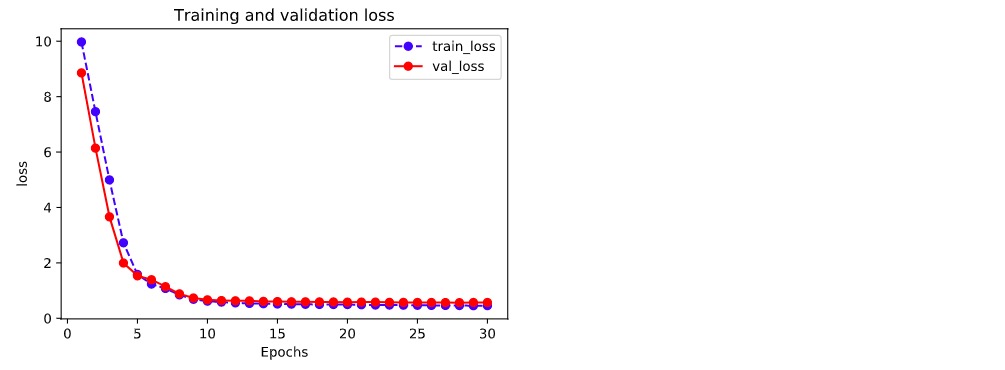
plot_metric(history,"AUC")
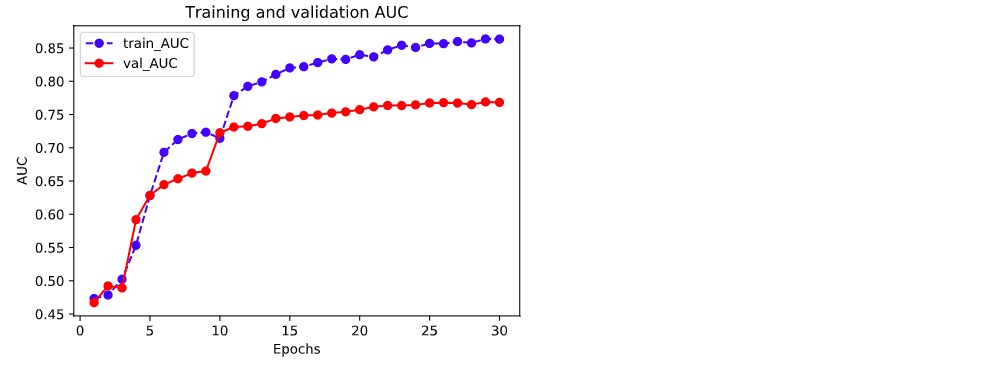
Let's take a look at the performance on the testing dataset.
model.evaluate(x = x_test,y = y_test)
[0.5191367897907448, 0.8122605]
5. Model Application#
#Predict the possiblities
model.predict(x_test[0:10])
#model(tf.constant(x_test[0:10].values,dtype = tf.float32)) #Identical way
array([[0.26501188],
[0.40970832],
[0.44285864],
[0.78408605],
[0.47650957],
[0.43849158],
[0.27426785],
[0.5962582 ],
[0.59476686],
[0.17882936]], dtype=float32)
#Predict the classes
model.predict_classes(x_test[0:10])
array([[0],
[0],
[0],
[1],
[0],
[0],
[0],
[1],
[1],
[0]], dtype=int32)
6. Model Saving#
The trained model could be saved through either the way of Keras or the way of original TensorFlow. The former only allows using Python to retrieve the model, while the latter allows cross-platform deployment.
The latter way is recommended to save the model.
(1) Model Saving with Keras
# Saving model structure and parameters
model.save('../../data/keras_model.h5')
del model #Deleting current model
# Identical to the previous one
model = models.load_model('../../data/keras_model.h5')
model.evaluate(x_test,y_test)
[0.5191367897907448, 0.8122605]
# Saving the model structure
json_str = model.to_json()
# Retrieving the model structure
model_json = models.model_from_json(json_str)
# Saving the weights of the model
model.save_weights('../../data/keras_model_weight.h5')
# Retrieving the model structure
model_json = models.model_from_json(json_str)
model_json.compile(
optimizer='adam',
loss='binary_crossentropy',
metrics=['AUC']
)
# Load the weights
model_json.load_weights('../../data/keras_model_weight.h5')
model_json.evaluate(x_test,y_test)
[0.5191367897907448, 0.8122605]
(2) Model Saving with Original Way of TensorFlow
# Saving the weights, this way only save the tensors of the weights
model.save_weights('../../data/tf_model_weights.ckpt',save_format = "tf")
# Saving model structure and parameters to a file, so the model allows cross-platform deployment
model.save('../../data/tf_model_savedmodel', save_format="tf")
print('export saved model.')
model_loaded = tf.keras.models.load_model('../../data/tf_model_savedmodel')
model_loaded.evaluate(x_test,y_test)
[0.5191365896656527, 0.8122605]
Please leave comments in the WeChat official account "Python与算法之美" (Elegance of Python and Algorithms) if you want to communicate with the author about the content. The author will try best to reply given the limited time available.
You are also welcomed to join the group chat with the other readers through replying 加群 (join group) in the WeChat official account.
